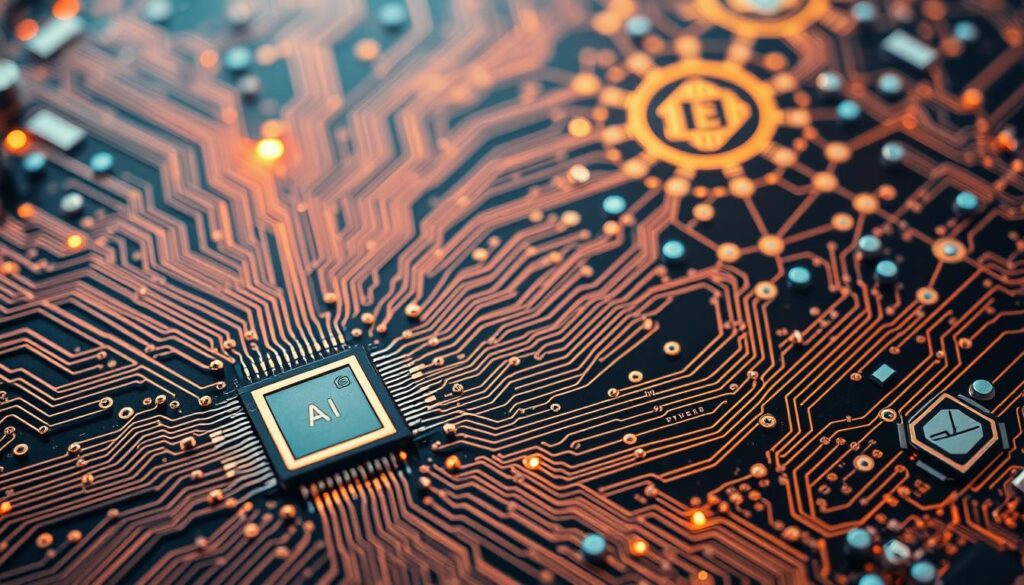Now Reading: Artificial intelligence DeFi protocol optimization Strategies
- 01
Artificial intelligence DeFi protocol optimization Strategies
Artificial intelligence DeFi protocol optimization Strategies

The financial world is undergoing a massive transformation. Two powerful forces are coming together to reshape how we interact with money. This guide explores the exciting convergence of smart technologies and decentralized systems.
This combination represents more than just a technical upgrade. It’s a complete rethinking of financial ecosystems. The precision and automation of advanced computing meet the transparency and resilience of trustless operations.
Readers will discover practical approaches for implementing these innovations. From yield farming improvements to security enhancements, the strategies covered here are actionable. Governance automation and portfolio management also receive detailed attention.
The article addresses both the incredible opportunities and important challenges. Developers, investors, and users all face unique considerations when integrating these systems. Understanding these factors is crucial for success in the evolving landscape of future finance.
By mastering these optimization methods, stakeholders can achieve greater efficiency. They can reduce risks, improve security, and unlock new value creation pathways. This guide serves as a roadmap for navigating this complex intersection of revolutionary technologies.
Key Takeaways
- The merger of advanced computing and decentralized systems creates powerful new financial possibilities
- Practical strategies exist for improving yield farming, security, and governance processes
- Both opportunities and challenges require careful consideration by all stakeholders
- Efficiency gains and risk reduction are significant benefits of proper implementation
- This technological convergence represents the next evolution in digital financial services
- Understanding these concepts is essential for navigating the future financial landscape
- Actionable approaches can be applied across various decentralized finance applications
Introduction: The Convergence of AI and DeFi
A powerful synergy between smart technologies and peer-to-peer networks is revolutionizing how financial services operate globally. This integration marks a significant shift in the fintech domain, combining the predictive power of advanced computing with the transparency of decentralized systems.
Setting the Context of AI in Decentralized Finance
The combination enhances what decentralized finance already offers. It adds intelligent automation to transparent, permissionless financial services. This creates more responsive and efficient systems.
Machine learning capabilities supercharge decision-making processes across global markets. They address critical challenges in current platforms. This includes improving capital allocation and security measures.
Why Now? The Rise of Innovative Fintech Solutions
The timing is perfect for this convergence. Decentralized systems have matured significantly, with over $80 billion in total value locked according to recent industry analysis. This scale demands more sophisticated solutions.
Several factors drive this innovation. Growing computational power and improved data availability enable smarter financial tools. Users now expect personalized, intelligent services in the finance space.
Traditional systems face limitations that these technologies overcome. They democratize access while enhancing efficiency. Early adopters are defining standards for next-generation infrastructure.
Understanding Decentralized Finance and Smart Contracts
The core principles of decentralized finance challenge centuries of traditional banking. This new model is built on open networks where users interact directly.
Defining DeFi: Transparency and Peer-to-Peer Financial Ecosystems
Decentralized finance creates a system without central intermediaries like banks. All activities happen directly between participants on a blockchain.
This peer-to-peer structure offers unprecedented transparency. Every transaction is recorded on a public ledger for anyone to see. This builds trust through open verification.
Smart Contracts: Automated and Permissionless Financial Interactions
These ecosystems are powered by smart contracts. Think of them as self-operating agreements written in code. They execute automatically when conditions are met.
This automation removes the need for trusted third parties. The contracts ensure that financial interactions are consistent and fair. Once deployed, they provide access to anyone, making the system truly permissionless.
From lending to trading, these automated contracts form the backbone of various defi applications. Their transparent nature allows users to track all transactions with confidence.
Key Concepts in AI and DeFi
At the heart of this convergence lie the distinct but complementary strengths of two advanced fields. One provides the transparent, structured data foundation. The other brings the analytical power to make that data useful.
Understanding these core concepts is the first step toward effective implementation.
Fundamental Elements of Artificial Intelligence
Artificial intelligence is a broad field focused on creating smart systems. These systems can learn, reason, and act. In finance, specific branches of AI are most relevant.
Machine learning is a cornerstone. It uses algorithms that improve with experience. Different learning approaches solve unique problems.
| Learning Type | Core Function | DeFi Application Example |
|---|---|---|
| Supervised Learning | Classification based on labeled data | Identifying legitimate vs. fraudulent transactions |
| Unsupervised Learning | Finding hidden patterns in data | Detecting unusual wallet behavior or market anomalies |
| Reinforcement Learning | Optimization through trial and error | Automatically adjusting fund allocation for best yield |
The Role of Data and Machine Learning in Finance
Data is the essential fuel for all machine learning models. The quality and quantity of data directly impact results. Blockchain technology offers a unique advantage here.
Its public ledger provides vast, verifiable datasets. Machine learning algorithms can analyze this on-chain information. They spot trends and make predictions far beyond human capability.
This enables predictive analytics for risk assessment and market forecasting. It transforms raw data into a powerful strategic tool for users and platforms.
Implementing Artificial Intelligence DeFi Protocol Optimization Techniques
Implementing computational enhancements across decentralized networks requires a phased approach with clear objectives. This systematic methodology ensures that smart technologies integrate seamlessly with existing financial platforms.
The process begins by defining specific goals for improvement. Teams should focus on measurable outcomes like security enhancements or efficiency gains.
Step-by-Step Guidelines for Optimization
Start by embedding computational considerations during the initial design phase. This forward-thinking approach prevents costly retrofitting later. Data collection mechanisms should support advanced analytical workloads from day one.
Building robust data pipelines represents a critical foundation. These systems must handle both on-chain and off-chain information securely. Quality data governance ensures reliable model performance.
Prioritize transparent decision-making processes that users can understand and trust. This builds confidence in automated recommendations. Cross-functional teams combining different expertise areas deliver the best results.
Adopt an iterative development strategy beginning with focused use cases. Validate model performance thoroughly before expanding applications. Continuous monitoring and refinement maintain system reliability over time.
Partnering with experienced specialists accelerates implementation while reducing risks. These collaborations provide access to proven solutions and industry best practices.
AI-Driven Yield Farming Optimization
Earning optimal yields across various decentralized networks demands sophisticated analytical capabilities that exceed human limitations. Smart systems now automate this complex process, scanning multiple platforms simultaneously.
These computational tools transform how users approach yield generation. They handle the heavy lifting of constant market monitoring.
Real-Time Market Analysis for Maximizing Returns
Advanced analytical models process vast amounts of market data continuously. They compare interest rates, token values, and risk factors across dozens of platforms.
This real-time analysis identifies the most profitable opportunities instantly. Systems like Genius Yield’s Smart Liquidity Vault demonstrate this capability effectively.
Optimizing APR Through Dynamic Fund Allocation
Dynamic allocation algorithms automatically shift funds based on profitability calculations. They execute complex transactions faster than human traders.
Even a 1% APR improvement on large asset pools generates significant additional returns. This justifies investment in sophisticated computational systems.
| Strategy Type | Monitoring Frequency | Return Optimization | User Involvement |
|---|---|---|---|
| Manual Farming | Daily checks | Basic returns | High maintenance |
| Rule-Based Automation | Hourly updates | Moderate improvement | Medium oversight |
| AI-Driven Systems | Real-time analysis | Maximum optimization | Minimal handling |
These smart farming tools democratize access to institutional-grade strategies. Everyday users benefit from continuous market adaptation without constant attention.
Enhancing DeFi Security with AI Integration
Protecting digital assets requires advanced security measures that evolve with emerging threats. Traditional methods struggle to keep pace with sophisticated attacks targeting decentralized systems.

These innovative approaches combine machine learning with blockchain transparency. They create robust defense systems for financial platforms and their users.
AI-Powered Fraud Detection and Anomaly Monitoring
Machine learning models analyze historical transactions to establish normal behavior patterns. They continuously monitor blockchain activity for unusual patterns that indicate potential fraud.
These systems can flag suspicious wallet addresses automatically. They detect coordinated attack behaviors across multiple platforms. Real-time alerts help prevent financial losses before they occur.
The financial impact of inadequate security is staggering. In 2022 alone, hacks resulted in $3.8 billion in losses. Advanced detection systems could drastically reduce such incidents.
Smart Contract Auditing Using Machine Learning
Automated code analysis tools examine smart contracts for vulnerabilities before deployment. They identify logic errors and potential attack vectors that manual reviews might miss.
These systems handle complex contracts with thousands of lines of code. They learn from new exploits across the entire ecosystem, strengthening defenses network-wide.
Real-world implementations demonstrate practical value. Olympix provides threat predictions, while Nethermind’s Audit Agent automates bug detection. QuillAI’s Shield offers specialized monitoring for decentralized applications.
By combining multiple techniques, defi platforms can create comprehensive security frameworks. These significantly reduce risks while maintaining system accessibility.
AI-Powered Trading Agents and Portfolio Automation
Smart trading solutions are democratizing access to sophisticated market strategies for everyday investors. These advanced tools handle complex portfolio management tasks automatically.
Custom price monitoring and portfolio maintenance no longer require manual effort. Investors can set preferences once and let the systems work continuously.
Automated Trading Bots and Their Market Impact
These intelligent agents scan multiple decentralized exchanges simultaneously. They detect arbitrage opportunities and execute trades at lightning speed.
Real-time data analysis enables instant response to changing market conditions. The systems learn from each transaction, improving their strategies over time.
| Trading Approach | Speed | Adaptability | Access Level |
|---|---|---|---|
| Manual Trading | Human-limited | Basic adjustments | Professional traders |
| Rule-Based Bots | Fast execution | Fixed parameters | Tech-savvy users |
| AI-Powered Agents | Instantaneous | Continuous learning | All investors |
Heron Finance demonstrates this technology’s maturity as an SEC-registered robo-advisor. It provides regulatory-compliant autonomous management services.
These platforms level the competitive playing field in financial markets. Retail users gain access to institutional-grade trading algorithms and portfolio management services.
Smart Governance and DAO Optimization Using AI
Community-led governance faces significant hurdles in achieving efficient and informed outcomes. Decentralized Autonomous Organizations (DAOs) often struggle with low participation and complex decision-making. Smart systems are now stepping in to provide crucial support.

These advanced tools act as virtual advisors for community management. They analyze lengthy proposals to assess their technical and financial impact. This helps all users understand the potential consequences of a vote.
Leveraging AI for Improved Proposal Analysis
Machine learning algorithms can process vast amounts of historical data. They compare new proposals against past successes and failures. This provides a data-driven risk assessment for every community decision.
The systems can also forecast potential outcomes. They simulate how a change might affect the ecosystem over time. This leads to more strategic choices for the future of the organization.
Enhancing DAO Decision-Making and Treasury Management
Treasury management is a critical area for improvement. Smart tools can analyze revenue streams and project funding needs. They recommend optimal strategies for capital allocation.
This approach helps users make better choices with shared assets. It ensures that resources support long-term goals. The entire governance process becomes more effective and transparent.
| Governance Challenge | Traditional Approach | AI-Enhanced Solution |
|---|---|---|
| Proposal Complexity | Manual review by time-limited members | Automated analysis with summarized insights |
| Voter Information | Relies on individual research effort | Personalized risk reports and recommendations |
| Treasury Allocation | Often reactive or emotionally driven | Data-driven projections and strategy optimization |
These innovations in governance are transforming how decentralized protocols operate. They empower communities with clearer information. This leads to stronger, more resilient organizations.
Real-World Use Cases of AI in DeFi
Several pioneering projects have successfully integrated advanced computing with blockchain-based financial platforms. These working systems demonstrate practical value across diverse financial services.
The convergence has moved beyond theory to deliver measurable results. Various applications now showcase this powerful combination.
Case Study: Autonomous Robo-Advisors in Asset Management
Heron Finance stands as a prime example of regulated innovation. This SEC-registered platform uses smart systems for autonomous asset management.
The service provides sophisticated portfolio solutions for private credit investments. It demonstrates how computational tools can achieve regulatory compliance while delivering advanced financial services.
Practical Examples of AI-Enhanced Yield Farming
Genius Yield’s Smart Liquidity Vault exemplifies yield farming optimization. It dynamically analyzes liquidity markets across multiple platforms.
The system automatically adjusts positions in real-time to maximize returns. This eliminates the need for constant manual monitoring by users.
These applications show how smart technologies enhance lending and investment platforms. They create more efficient financial solutions for everyday users.
Overcoming Challenges in AI-Driven DeFi Integration
Combining machine learning capabilities with blockchain-based finance presents unique challenges that must be resolved for widespread adoption. These obstacles span technical, ethical, and regulatory domains.
Thoughtful design and continuous refinement are essential to ensure benefits without introducing new systemic risks. Developers must balance innovation with core decentralized principles.
Addressing Data Privacy and Model Bias
Data privacy creates significant tension in this integration space. Machine learning models require extensive datasets, while users value blockchain pseudonymity.
Innovative approaches like federated learning and zero-knowledge proofs help balance these needs. They enable model training without compromising individual information.

Model bias poses serious risks in lending and governance systems. Algorithms trained on historical data may perpetuate existing inequalities.
This contradicts the inclusive ethos of decentralized finance. Continuous testing and transparent reporting help mitigate these concerns.
Navigating Regulatory and Technical Hurdles
Regulatory uncertainty adds complexity to this emerging field. Global frameworks for both technologies are still developing.
Computational costs present practical barriers. Running sophisticated models directly on blockchain networks proves expensive.
Hybrid architectures balance on-chain security with off-chain computation. Reliable oracle systems connect these components securely.
| Challenge | Impact | Mitigation Strategy |
|---|---|---|
| Data Privacy | User resistance to extensive data collection | Federated learning, zero-knowledge proofs |
| Model Bias | Unfair decisions in lending/governance | Explainable AI, continuous bias testing |
| Computational Costs | High gas fees for on-chain execution | Hybrid architectures with oracles |
| Regulatory Uncertainty | Compliance ambiguity for novel systems | Interdisciplinary legal/tech collaboration |
Overcoming these challenges requires collaboration between developers, researchers, and legal experts. This ensures defi systems remain trustworthy and aligned with decentralized values.
Future Trends in the Convergence of AI and DeFi
Emerging technologies are reshaping the landscape of decentralized financial applications in unprecedented ways. The next phase of development will bring more autonomous and intelligent systems.
These advancements promise to create self-managing financial platforms. They will handle complex operations with minimal human oversight.
Cross-Protocol Intelligence and Real-Time Optimization
Cross-protocol intelligence represents a major leap forward. Smart systems will analyze user behavior across multiple blockchain networks simultaneously.
This creates seamless financial experiences. Transactions and resources automatically route to maximize efficiency.
On-chain AI oracles will provide verifiable predictions directly to smart contracts. This bridges off-chain computation with on-chain execution.
The Potential of Quantum-Ready Finance Solutions
Quantum-ready finance solutions combine advanced machine learning with quantum computing capabilities. They tackle problems currently impossible for classical computers.
These technologies enable real-time risk modeling across entire financial systems. They optimize complex multi-variable strategies at unprecedented scales.
| Current Capability | Future Enhancement | Impact on Users |
|---|---|---|
| Single-protocol analysis | Cross-chain intelligence | Seamless multi-platform experience |
| Manual risk assessment | Real-time quantum modeling | Instant protection from market shifts |
| Basic automated trading | AI-driven portfolio management | Personalized investment strategies |
The integration of these technologies points toward more accessible and resilient financial solutions. This represents the next evolution in future finance.
Strategic Steps to Implement AI in DeFi Protocols
The journey toward intelligent financial platforms begins with thoughtful implementation strategies that prioritize long-term success. Proper planning ensures these advanced systems deliver maximum value to users and developers alike.

Embedding AI Early in the Design Process
Integrating smart systems during initial development stages creates significant advantages. Early consideration allows for architecture decisions that support computational requirements.
Teams can design smart contracts with compatible interfaces from the start. This forward-thinking approach prevents costly retrofitting later. It also establishes proper data collection mechanisms.
Building Robust Data Pipelines for Reliable Analytics
Strong data infrastructure forms the foundation for effective machine learning solutions. Quality information enables accurate predictions and recommendations.
Comprehensive governance frameworks ensure data consistency across diverse sources. Secure channels handle real-time information flows between blockchain networks and analytical systems.
| Implementation Approach | Key Focus Areas | Expected Benefits |
|---|---|---|
| Early Integration | Architecture design, contract interfaces, data collection | Cost efficiency, future-proof systems |
| Robust Pipelines | Data quality, security, real-time processing | Reliable analytics, accurate predictions |
| Expert Partnership | Specialized knowledge, proven methodologies | Faster deployment, reduced risks |
These strategic steps create financial platforms with enhanced capabilities. Users gain access to more sophisticated services while enjoying improved security and efficiency.
Conclusion
The combination of smart technologies and decentralized systems reshapes finance fundamentally. This partnership creates more open and efficient financial services for all users.
These technologies bring real benefits today. They improve security and expand access to advanced tools. The integration addresses key challenges like fraud prevention.
Success requires careful design that prioritizes fairness. The true test lies in building systems that serve everyone equally. Early adopters will help shape this future financial system.
This evolution points toward more resilient and intelligent solutions. The journey continues as these platforms grow smarter and more connected.
FAQ
How does machine learning improve security in decentralized finance?
Machine learning algorithms analyze transaction patterns across blockchain networks to detect anomalies. This helps identify potential fraud and security threats in real-time. These systems can monitor smart contract interactions, flagging suspicious activity before it impacts users.
What is the role of data in optimizing yield farming strategies?
High-quality, real-time data is essential for maximizing returns from yield farming. Predictive analytics use this data to forecast market movements and liquidity shifts. This allows for dynamic fund allocation, automatically moving assets to protocols with the best annual percentage rates (APR).
Can AI help with decentralized autonomous organization (DAO) governance?
Yes, these technologies can significantly enhance DAO operations. They analyze proposal data to predict outcomes and assess risk. This provides members with deeper insights for improved decision-making on treasury management and project funding.
What are the main risks of integrating advanced algorithms into financial systems?
Key risks include model bias based on incomplete data and potential regulatory challenges. Ensuring the security of these automated systems is also critical. Transparent code and continuous monitoring are vital for managing these risks effectively.
How do automated trading bots impact the DeFi market?
These bots execute trades based on pre-set algorithms and market analysis. They can increase market efficiency and liquidity. However, they also require robust risk management to prevent flash crashes or unintended market manipulation.
Are there real-world examples of AI in lending platforms?
Several platforms now use predictive models to assess borrower creditworthiness more accurately. This allows for automated, secure lending with lower default rates. The integration enhances access to financial services while managing risk.











